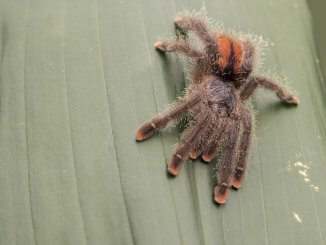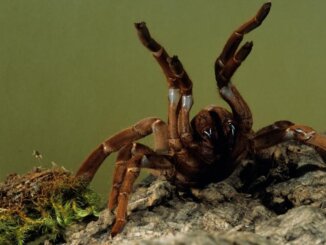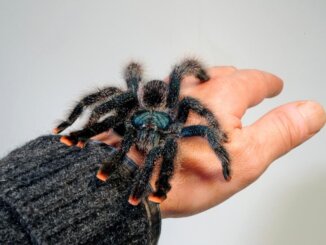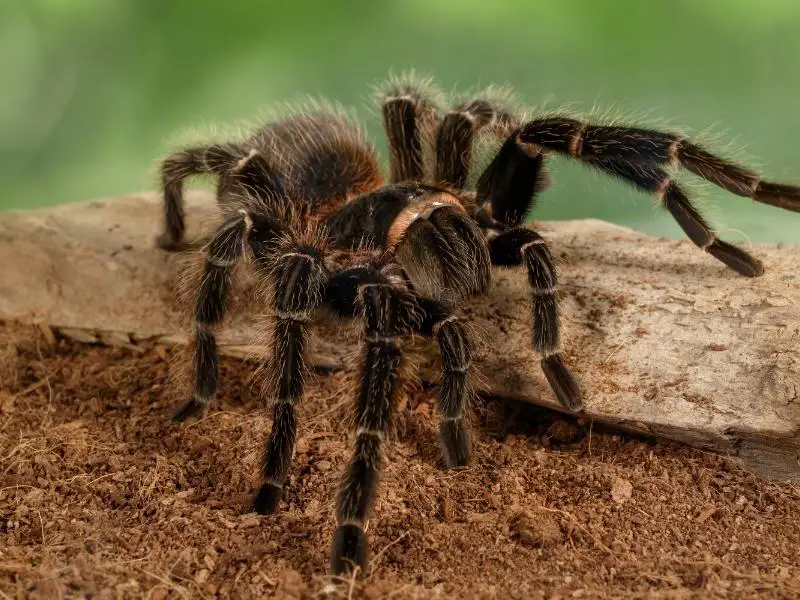
The Lasiodora parahybana, or salmon pink bird-eater, is a brown, hairy tarantula found in northeastern Brazil.
Caring for salmon pink bird-eaters is easy because the spiders are hardy and adaptable to different temperatures and humidity levels.
Lasiodora Parahybana Overview
| Common Name: | Salmon pink bird-eater |
| Scientific Name: | Lasiodora parahybana |
| Natural Habitat: | Forest floors in Brazil; hot, humid climate |
| Adult Size: | Up to 11 inches |
| Average Lifespan: | 3–5 years (males), up to 15 years (females) |
| Diet: | Carnivore |
| Housing: | Minimum 5 inches high and 18 inches across, 75–85°F, 75%–85% humidity |
| Experience Level: | Beginner |
Origin
Lasiodora parahybana is a spider endemic to Paraíba, a region in northeastern Brazil.
Salmon pink bird-eater spiders, as they are commonly known, are the fourth-largest tarantulas in the world, and are commonly found on hot, humid rainforest floors.
The Brazilian Amazon rainforest experiences a dry period throughout four to five months of the year, and salmon pink bird-eaters have adapted to different climates and humidity levels in the wild.
Appearance and Behavior
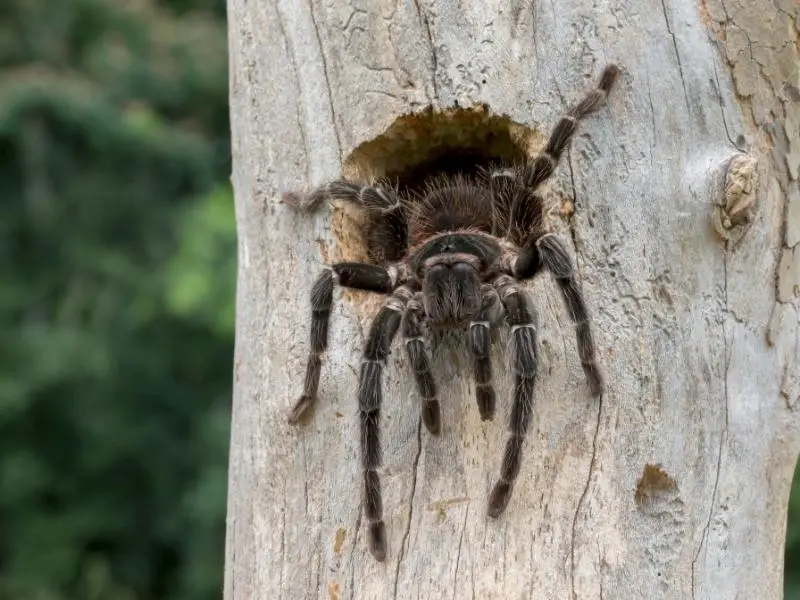
The salmon pink bird-eater has a furry, bulky, black or brown body with a cluster of eight eyes on the front of its head.
Young salmon pink bird-eaters are pinkish, and the spiders darken to brown or black as they grow. The tarantula’s hairs, which stick out of its head, legs, and abdomen, are orange-brown.
Salmon pink bird-eaters don’t have good eyesight, and the spiders rely on their sense of touch to avoid predators and find prey.
The pedipalps, a pair of feelers attached to the spider’s head, are used to sense and capture prey, and the fine hairs on the spider’s body pick up air movement and protect the spider from predators.
Male salmon pink bird-eaters have bolder colors and more reddish abdominal coloring than females.
Size and Lifespan
The average lifespan of the salmon pink bird-eater is between 3 and 5 years for males and up to 15 years for females.
In the wild, salmon pink bird-eaters have a leg span of more than 11 inches. In captivity, the spider grows up to 8–10 inches, and can surpass a leg span of 6 inches within its first year.
Temperament
The salmon pink bird-eater has a bold personality, but the spider is rarely aggressive and doesn’t pick fights. The older the spider, the more peaceful its temperament.
When provoked, salmon pink bird-eaters are more likely to retreat than attack. However, these spiders are still capable of protecting themselves against potential predators.
The spider presses its barbed hairs into enemies, and these hairs stick to the skin and cause irritation.
Salmon pink bird-eaters aren’t sociable, and you shouldn’t house several spiders of the L. parahybana species together because cannibalism between the spiders could occur.
The salmon pink bird-eater can be handled, but it is skittish and will retreat from loud noises, sudden movements, or rough handling.
Housing Lasiodora Parahybana
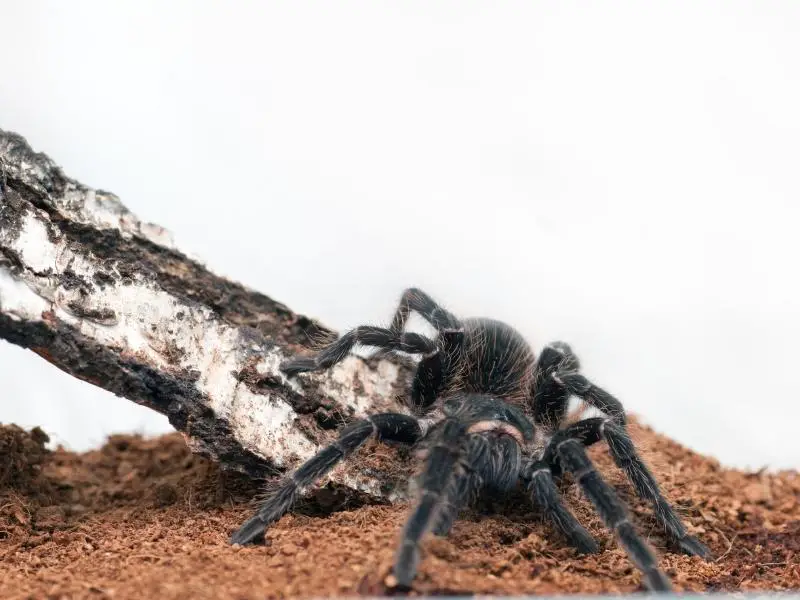
The salmon pink bird-eater’s natural habitat is tropical, humid rainforest floors in Brazil.
Salmon pink bird-eaters don’t climb or burrow much in the wild, and this should be reflected in the choice of tank, substrate, and decorations in captivity.
House salmon pink bird-eaters in an aquarium.
Enclosure size
The size of the salmon pink bird-eater’s enclosure should be at least three times the tarantula’s leg span.
When buying a young salmon pink bird-eaters, remember that the spider will grow, and the tank should be suitable for the spider’s adult size.
The minimum enclosure size is 5 inches high and 18 inches across. Salmon pink bird-eaters don’t climb or dig in the substrate, so extra tank height isn’t required.
The substrate should be at least 3 inches deep for the spider to dig shallow burrows.
Lighting
The salmon pink bird-eater is a nocturnal tarantula that is most active during the night. Don’t use lighting in the tank, and place the tank in a location that is shadowed from the light in the room.
Housing salmon pink bird-eaters in complete darkness all day isn’t necessary, but make sure the spider is kept in darkness overnight.
Temperature and Humidity
Although salmon pink bird-eaters have adapted to thrive in a range of climates, the conditions in the enclosure should be consistent to reduce the risk of stress and disease.
The temperature of the enclosure should be between 75 and 85°F, to replicate the tarantula’s tropical habitat in the wild.
Maintain a humidity of between 75% and 85%. Dampening the substrate helps raise humidity in the tank.
To ensure temperature and humidity levels are consistent, use a thermometer and a hygrometer to take twice-daily measurements, once in the morning and once at night.
Adult salmon pink bird-eaters molt about once per year, and high humidity can help the spiders to easily shed their exoskeletons.
Substrate and Decoration
The best substrate choices for salmon pink bird-eater tanks are peat-free and chemical-free potting compost or coir. Both substrates are hygienic, cheap, and easy for a tarantula to burrow in.
Some substrate needs to be soaked before use, so follow the manufacturer’s instructions when setting up the tank.
Decorate the enclosure with plants, rocks, and logs, to give the spider shelter and a place to hide.
Use artificial plants that won’t be affected by a lack of sunlight. Use a shallow dish to provide a source of clean water to the spider.
Cleaning
Cleaning your salmon pink bird-eater’s enclosure maintains hygienic tank conditions, reduces unpleasant smells, and reduces the potential for disease.
This tarantula is clean and hygienic, and complete tank cleans aren’t frequently needed if you keep up with regular spot-cleaning.
Once a day, remove and rinse out the water dish, and top it up with fresh water. Use long forceps to grab and remove items that need to be removed, such as molted spider skins, leftover food, moldy areas of substrate, and spider waste.
The spider can remain in the cage during spot-cleaning, and using forceps will make it easy to reach into the tank without startling the spider.
Once a year, place your salmon pink bird-eater in a backup tank and deep-clean the home tank. Remove all items and wash out the tank with warm, soapy water.
Leave the tank to dry, then add a fresh layer of substrate, and new tank decorations if necessary.
Lasiodora Parahybana Care
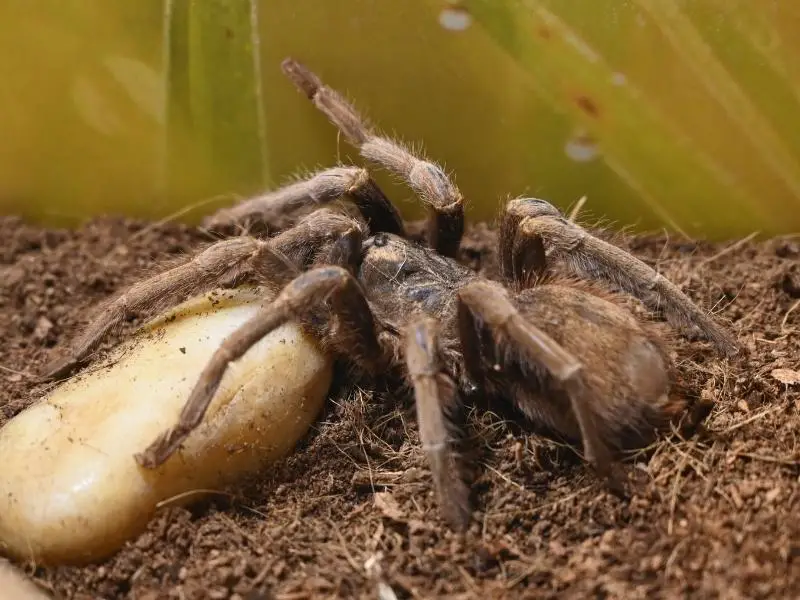
Caring for salmon pink bird-eaters is easy because the tarantulas are hardy and spend most of their time on the substrate, with no risk of injury.
The salmon pink bird-eater requires regular feeding, constant access to water, and clean tank conditions to thrive in captivity.
Food and Water
Salmon pink bird-eaters are fast-growing tarantulas that need a lot of protein-rich food to grow properly. In the wild, the spiders eat a carnivorous diet of mice, lizards, frogs, insects, and snakes.
Replicate this diet in captivity and feed your salmon pink bird-eater a diet of mice, baby crickets, locusts, mealworms, grasshoppers, fruit flies, and moths.
Live food is better than frozen-thawed food because catching live prey satisfies the spider’s hunting instincts.
After feeding your salmon pink bird-eater, remove uneaten food and leftover insect shells from the tank to prevent injury to the tarantula.
Provide a shallow water bowl for the spider to access drinking water throughout the day.
Feed young tarantulas and adult tarantulas between two and three times per week. Provide small food portions, such as baby mice and baby crickets, for young tarantulas.
Don’t feed salmon pink bird-eaters plant-based foods because these foods don’t meet the tarantulas’ nutritional needs and will be ignored by your pet.
Handling
Although salmon pink bird-eaters are docile, the spiders are skittish and startle easily. Handling your salmon pink bird-eater is possible, but you should handle the spider carefully to prevent it from escaping.
Don’t let young children handle a salmon pink bird-eater because hyper movements will scare the spider off.
Don’t handle a salmon pink bird-eater that has just molted because the tarantula’s body will be soft and fragile and more easily damaged.
To handle a salmon pink bird-eater, follow these steps:
- Wash your hands to remove food scents, which the salmon pink bird-eater could mistake for prey
- >Over several weeks, accustom the spider to your presence by placing your hand inside the tank and laying it flat on the substrate
- Once the salmon pink bird-eater is used to your presence, it should feel comfortable climbing onto your hand. Place your hand flat on the substrate with your palm facing up and gently coax the spider to your palm using a finger from your other hand
- Allow the tarantula to walk freely across your hand. Stay still and quiet to prevent the spider from feeling threatened
- If the salmon pink bird-eater settles on your palm, it may be safe to lift the spider out of the tank. Raise your hand slowly and carefully, avoiding fast movements that could cause the spider to fall or jump from your hand and injure its delicate exoskeleton
- Return the salmon pink bird-eater to the tank after a maximum of five minutes to prevent the spider from becoming stressed
Common Health Issues
There are no specific diseases that affect the L. parahybana, but this spider is prone to several common tarantula health problems:
Dehydration
Dehydration occurs in spiders that are housed in tanks with too much ventilation, a lack of food, or a lack of water.
Signs of dehydration include a shriveled appearance and a shrunken abdomen. Treat dehydration by providing water in a large, shallow dish, spraying the substrate to moisten the atmosphere, and reducing ventilation in the tank.
Mold and Fungal Diseases
Failing to properly clean the tank can lead to an accumulation of mold and fungus due to the hot, humid climate inside the tank.
Mold and fungus diseases are characterized by yellow-white plumes on the spider’s body, such as the tips of the legs and the underside of the abdomen.
Prevent mold and fungal diseases by ensuring the substrate is damp, not wet, and providing adequate ventilation in the tank. Use an antiseptic solution recommended by your veterinarian.
Mites
Mites are common in a typical tarantula setup. Although mites don’t harm tarantulas, mites use tarantulas as a mode of transportation, and removing mites from a tarantula is difficult because the insects bite down onto the tarantula’s exoskeleton.
Reduce mites by ensuring good cage ventilation and removing leftover food. Use a cotton bud coated with petroleum jelly to gently swab the affected parts of the spider. The mites should transfer onto the cotton bud.
Molting
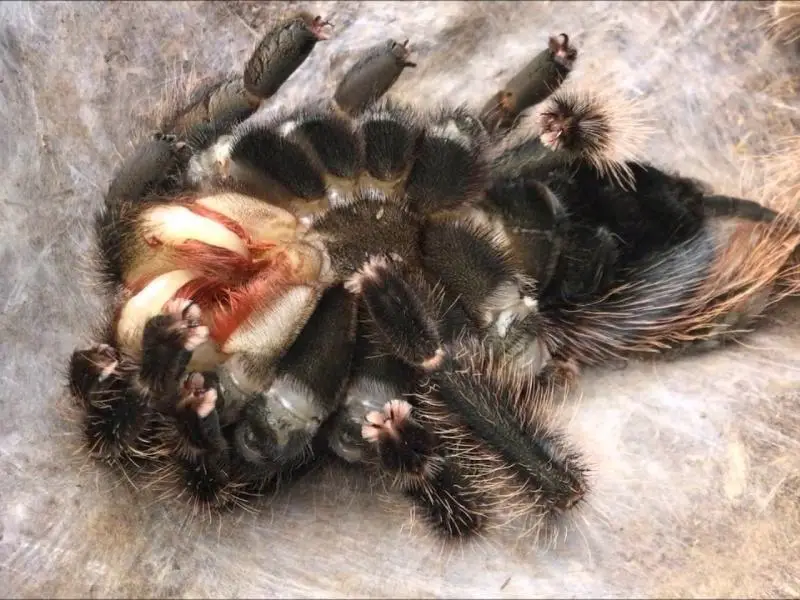
Salmon pink bird-eaters must molt — or shed their exoskeletons to grow — regularly.
The older the spider, the less frequently it molts. Baby salmon pink bird-eaters molt every three or four weeks. Once the spider is past two-thirds grown, it will molt about once a year.
A decrease in appetite and activity signals that the salmon pink bird-eater is about to molt. During the molting process, the spider requires plenty of humidity to easily shed its exoskeleton.
Once the process has finished, the spider’s body will be soft and vulnerable until the new exoskeleton hardens.
Don’t feed a newly-molted salmon pink bird-eater for a week because live insects can damage the spider’s fragile exoskeleton.
Breeding
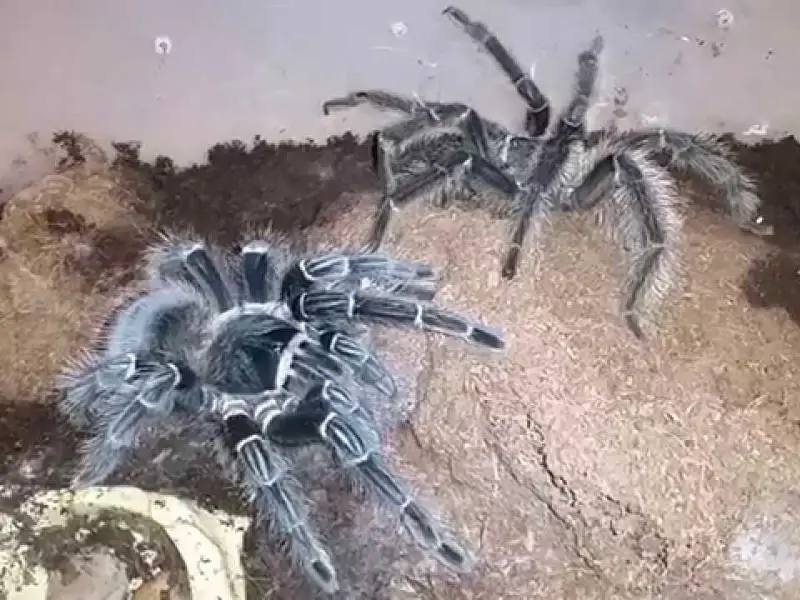
Salmon pink bird-eaters are moderately difficult to breed. The spiders are solitary creatures, and placing two spiders in the same tank, even for breeding purposes, can cause conflict.
There isn’t much information on how to breed salmon pink bird-eaters and how to raise their babies, so breeding should be attempted by expert spider-keepers only.
Most salmon pink bird-eaters become sexually mature before they reach two years of age.
To breed a pair of salmon pink bird-eaters, follow these steps:
- Place a male and a female salmon pink bird-eater in the breeding tank
- The male will spin a patch of silk and deposit his sperm onto the silk, before sucking the sperm into his feelers
- The male will approach the female, who will open her fangs and rear up
- In this position, the male secures the females’ fangs using the hooks on his front legs, then inserts his pedipalps into the underside of the female’s abdomen
- Return the spiders to their home tanks. The female will spin a thick carpet of silk on the base of the tank, before laying up to 2,000 eggs on this carpet
- The female will cover the eggs with silk, forming an egg sack, which protects the eggs until they hatch several weeks later
- Feed the spiderlings a protein-rich diet of pinhead crickets twice per week, and provide water in a bottle cap until the spiderlings are big enough to safely drink from a shallow water dish
Choosing and Buying Lasiodora Parahybana
The average cost of a salmon pink bird-eater is $30 to $150. Female salmon pink bird-eaters cost more than males because females live three times as long as males.
Spiderlings are cheaper than sexed adults because determining whether a young spider is male or female is difficult.
When choosing a salmon pink bird-eater, look for spiders aged around 1 or 2 years old.
At this age, the spider is old enough to be sexed, but young enough to adapt quickly to a new enclosure. Young spiders get used to human contact faster than old spiders, too.
Buy from a reputable, experienced breeder who is enthusiastic about tarantulas and can discuss this spider’s care levels in detail.
Buying from a reputable breeder also ensures that the spider has been brought up in hygienic conditions, reducing the risk of illness.
If you can, examine the spider in person to check for red marks, parasites, or missing patches of hair. Check that the spider is moving, eating, and drinking normally.

